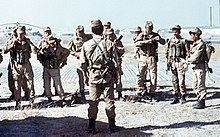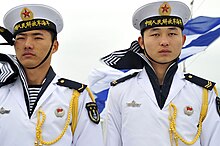 A man wears a blue, sleeveless telnyashka at a
Victory Day celebration (2012) in
Donetsk. | |
| Type | Undershirt |
|---|---|
| Place of origin | Russia, former Soviet Union |
The telnyashka ( Russian: тельняшка, pronounced [tʲɪlʲˈnʲaʂkə]) is a horizontally striped undershirt worn as uniform by Russian military personnel. It has stripes in white and in a color that varies according to the unit's affiliation. The most common second color is blue, but a number of other colors are also in use. The garment comes in varying thicknesses and may be sleeved or sleeveless.
Technical details

The uniforms of Russia's Naval, Airborne and Naval Infantry personnel do not include conventional collared shirts. Open-fronted jackets of various designs make the distinctively striped telnyashka a conspicuous part of the clothing of branches of the Russian armed forces.
Telnyashkas are also available to civilian customers and may come in a variety of knittings. Single-stranded knitting is the standard military-issue variant, but double- and quadruple-stranded knitting for increased warmth can be produced. A quadruple-stranded telnyashka is thick enough to keep the wearer warm with nothing else on, even at 5 °C (41 °F), as it was originally developed to be worn by military divers under a dry suit.

History

The Russian telnyashka originated in the distinctive striped marinière blouse worn by merchant sailors and fishermen of Brittany, [1] who adopted this style to distinguish them from other sea-going nationalities. The fashion was later adopted and popularized by the French Navy and other navies of the pre-dreadnought era. Sailors of the modern French Navy still wear these garments in certain orders of dress.
The Imperial Russian Navy adopted the blue and white striped telnyashka blouse during the 19th century. The tradition of Russian or Soviet ground troops wearing a naval uniform comes from Soviet Navy sailors who fought as shore units during World War II. It is exemplified by the famed Soviet sniper Vassili Zaitsev, a petty officer in the Soviet Pacific Fleet who volunteered for army duty, but refused to give up his telnyashka because of the pride it engendered.

Vasily Margelov, who was later to modernize the Soviet Airborne Forces (VDV), had previously served with a Naval Infantry unit in World War II, and procured telnyashkas for the VDV as a mark of their elite status.
Use in the Russian military
Although the blue and white striped telnyashka is the best-known, other colors are in use. [2] The colored telnyashka stripes usually match the beret, except for the Marines, who have a blue striped shirt and black beret.

Blue and white stripes
-
Russian Navy - the telnyashka was first worn by the 19th century
Imperial Russian Navy and has been worn by Russian sailors ever since.
- Russian marines, PDSS and submarine crewmen - as branches of the Navy they wear the blue and white telnyashka with their dress uniform, but in the field they use a black and white striped variant. [3]
- The maritime service of the Border Troops follows the traditions of the Navy, including its ranks and the telnyashka
-
Russian Airborne Troops (VDV). Introduced by General
Vasily Margelov
[4]
[5] to the displeasure of Admiral
Sergey Gorshkov.
[6]
- GRU Spetsnaz - military intelligence special forces often wear VDV uniforms including the blue telnyashka.
- KGB Border Troops airborne units use VDV insignia and uniform
- Federal Security Service spetsnaz units and the Kremlin Regiment [7] of the Federal Protective Service wear cornflower blue telnyashkas as part of their uniform.
- KGB and FSB officers in military counter-intelligence roles wear the same color as that of the unit that they are assigned to. [8]
Green and white stripes
- Border Service of the Federal Security Service of the Russian Federation follow the traditions of their Soviet predecessor and wear the green telnyashka (except for its maritime and airborne units). Green is also used by the Border Troops of Belarus. [9]
Red and white stripes
- The National Guard of Russia (Rosgvardiya) wear dark red and white striped telnyashkas with dark red berets, as did its predecessor, the Interior Troops. [10]

Orange and white stripes
The Russian Ministry of Emergency Situations wears an orange and white striped telnyashka, introduced by Sergei Shoigu when he was its Minister. The Ministry is mostly in charge of civil defence and firefighters and uses army-style ranks. [11]
In other countries


The Bulgarian 68th Special Forces Brigade uses the telnyashka as part of its uniform.[ citation needed] Sailors of the Cuban Revolutionary Navy wear telnyashkas with blue stripes as part of their uniform.
The Korean People's Army Navy also uses them with their uniforms.

In popular culture
Soviet 1936 film The Sailors of Kronstadt started aestheticization[ citation needed] of telnyashka with a scene of a Bolshevik sailor emerging from the sea in his torn undershirt after surviving an attempted execution by drowning.
The telnyashka is worn by a number of popular non-military characters of cinema and children's cartoons, notably The Wolf in Nu, pogodi and Matroskin the Cat in Troe iz Prostokvashino.
The telnyashka is worn by members of various factions in the 2019 video game Metro Exodus.
In the 2010 video game, Call of Duty: Black Ops, Lev Kravchenko, the secondary antagonist can be seen wearing a telnyashka under his jacket, other characters such as Viktor Reznov can be seen wearing this outfit on his assault on Rebirth Island with Alex Mason. Mason himself is depicted as wearing this outfit when it is revealed that Viktor Reznov is actually dead, and that any depiction of Reznov prior was actually of Mason.
In the 2019 video game, Call of Duty: Modern Warfare, a Russian soldier, J-12, is portrayed wearing a sleeveless telnyashka under a tactical ammo vest during Farah Karim's flashback of the Russian invasion of Urzikstan. Other Russian characters such as General Roman Barkov, Sergeant Kamarov as well as Multiplayer operative Maxim "Minotaur" Bale can also be seen wearing blue telnyashkas with the former two wearing it beneath their uniforms. Other Campaign character, Chimera operative "Nikolai", wears a dark telnyashka shirt as part of his Multiplayer skins.
There is a popular saying: "We are few in number, but we are in telnyashkas!" ( Russian: Нас мало, но мы в тельняшках!, romanized: Nas malo, no my v telnyashkakh!), alluding to the reputation of troops who wear the shirt as ferocious warriors. [12] [13]
See also
References
- ^ Foreman, Katya (9 March 2016). "The ultimate symbol of French cool". BBC News. Retrieved 11 May 2023.
- ^ "Тельняшка — символ настоящих воинов [The Telnyashka - Symbol of True Warriors]". 2015-08-19.
- ^ "Расцветки тельняшек - о чём они говорят | Милитари магазин". military-plus.ru. Retrieved 2022-04-09.
-
^ Campbell, David (2017).
Soviet Paratrooper Vs Mujahideen Fighter. London: Bloomsbury Publishing. p. 15.
ISBN
9783658222901. Retrieved 11 May 2023.
a long-sleeved version of the ubiquitous telnyashka striped vest, a legacy of Major-General Vasily Filippovich Margelov's appointment as head of the VDV...Margelov had served in the Naval Infantry during the Great Patriotic War and brought the telnyashka across from them to his new branch of the service as a sign of the VDV's elite status
-
^ Schofield, Carey (1993).
The Russian Elite. Greenhill Books. p. 34.
ISBN
9781853671555.
Magelov indeed introduced the telnyashka, the blue-and-white striped t-shirt that was to become the trademark of the VDV.
- ^ Грозный, Олег (2020-07-31). "Десантная тельняшка родилась на Ладоге". redstar.ru. Retrieved 2022-04-09.
- ^ "Президентский полк". forma-odezhda.com. Retrieved 2022-04-09.
- ^ "Тельняшка - морская душа. И не только морская... » Чекист.ru". www.chekist.ru. Retrieved 2022-04-09.
- ^ "РЕПОРТАЖ: Один день из жизни погранзаставы на рубеже трех стран". www.belta.by (in Russian). 2019-05-28. Retrieved 2022-04-09.
- ^ "Форма Росгвардии нового образца - чем регламентируется, обмундирование и экипировка подразделений и срочников, цвета камуфляжа, знаки различия ФСВНГ" (in Russian). 2020-05-26. Retrieved 2022-04-09.
- ^ "Новая форма мчс 2018 - 8 Октября 2021 - Блог - SPETSVOIN". www.spetsvoin.ru. Retrieved 2022-04-09.
-
^
"Справочник по фразеологии". Academic.ru (in Russian). Retrieved 6 June 2023.
"The expression first appeared in the Great Patriotic War amongst sailors who, together with the infantry, took part in combat operations on land and were famous for their fearlessness and heroism. The expression means: we are few, but we are serious opponents for the enemy and it is not easy to defeat us.
- ^ "«Нас мало, но мы в тельняшках». История морской рубахи в России", Arguments and Facts
External links
- Zaitsev, Vassili. "Notes of a Russian Sniper." Trans. David Givens, Peter Kornakov, Konstantin Kornakov. Ed. Neil Orkent. Los Angeles: 2826 Press Inc., 2003.
- Presidential Decree N 921 of 28.08.2006 ( http://lawrussia.ru/texts/legal_739/doc739a408x944.htm)